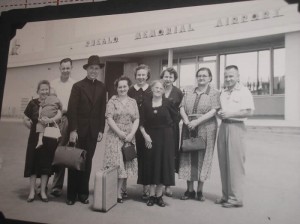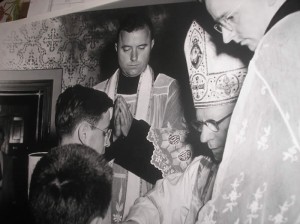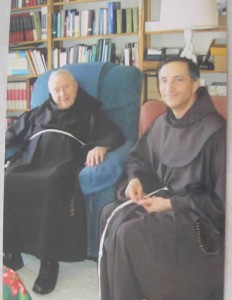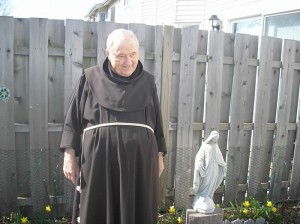The following is excerpted from Father’s July-August-September 2011 Newsletter. God bless you, Father!
JUST PERFECT for a priest jubilarian are the following words of one of the stanzas of Father Frederick William Faber’s immortal Eucharistic hymn, Jesus, My Lord, My God, My All:
Had I but Mary’s sinless heart
To love thee with, my dearest King!
O, with what bursts of fervent praise
Thy goodness, Jesus, would I sing!
Yes, with what bursts of the fervent praise and love and thanksgiving of Mary’s Immaculate Heart does an aging priest of 70 years address the infinite goodness of Jesus, the Eternal High Priest! And how easily do also the following words of that same sinless Heart of Mary come up from such a priest’s own unworthy heart and onto his lips: Magnificat Anima Mea Dominum — My Soul Magnifies the Lord!
The day of the beginning of specially fervent praise and love and thanksgiving for this priest of 70 long years was Sunday morning, May 18, 1941, when he was ordained, according to the traditional Catholic rite of ordination, by Chicago’s Bishop Bernard Sheil, in the Quigley North Seminary Chapel, together with a small group of other ordination candidates from different Religious Orders and Congregations within the Chicago area. Usually, for such a small group, there is no organist nor choir in the Quigley Chapel choir loft, but, much to our pleasant surprise, we suddenly heard the beautiful Litany of Saints being sung — a litany which is always a part of an ordination ceremony.
 As a bit of a distraction, and before telling about my First Solemn Mass, let me mention that 3 days before the May 18th ordination, that is, on Thursday, May 15th, an unforgettable, tremendously powerful mid-afternoon storm blew in from the northwest upon our Lemont, Illinois, Franciscan Monastery (St. Mary’s Seminary) of the Slovene Franciscan Fathers. Among the trees blown down on the monastery grounds was a beauty of a tall majestic elm tree right in front of the monastery building. There was speculation by weather experts that a tornado funnel may possibly have skipped through, but without quite coming down hard on the ground.
As a bit of a distraction, and before telling about my First Solemn Mass, let me mention that 3 days before the May 18th ordination, that is, on Thursday, May 15th, an unforgettable, tremendously powerful mid-afternoon storm blew in from the northwest upon our Lemont, Illinois, Franciscan Monastery (St. Mary’s Seminary) of the Slovene Franciscan Fathers. Among the trees blown down on the monastery grounds was a beauty of a tall majestic elm tree right in front of the monastery building. There was speculation by weather experts that a tornado funnel may possibly have skipped through, but without quite coming down hard on the ground.
As so often happens after a big storm, chilly air moved in from the north for the next few days and, as we headed for Quigley Seminary on the Sunday morning of May 18, it was a bit chilly.
And now about my First Solemn Mass. The date of that Mass was delayed until June 15, so that relatives and acquaintances, especially those from Pueblo, Colorado, could make it. The privileged church for such a rare solemnity was St. Ignatius Church in the small town of Neodesha (population 3,300) in southern Wilson County, southeast Kansas, some 30 miles north of the Oklahoma border. It was in that church that I had been baptized (on December 5, 1915), had received my First Holy Communion (on May 21, 1925, four days after the canonization of St. Therese Martin, the Little Flower), and was confirmed by Wichita’s Bishop Schwertner (May 14, 1928).
The long-time pastor of Neodesha’s St. Ignatius Parish was the highly-regarded Father George Reinschmidt (born in Rochester, New York). The deacon for my First Solemn Mass was the many-years major superior of Lemont’s Slovene Franciscan Fathers, Very Reverend Father Benedict Hoge, O.F.M. (native of Cleveland, Ohio), while the subdeacon was our Lemont Franciscan Father Cyril Shircel (born in Sheboygan, Wisconsin), a Doctor of Philosophy graduate of Washington’s Catholic University, and also a zealous and very talented promoter of the philosophy and theology of the renowned 13-14th century Franciscan John Duns Scotus. It was this Father Cyril who later arranged for me to enroll in the Catholic University School of Sacred Theology, with the final outcome being that I there gained the degree of Doctor of Sacred Theology. The title of my doctoral dissertation is The Christology of Zeno of Verona.
Interestingly enough, my hometown of Neodesha, Kansas, was the location of the first commercial oil well west of the Mississippi River, an oil well that to this day goes by the historic name of Norman Number One oil well. Standard Oil Company operated a refinery in Neodesha for about 75 years. Noteworthy, too, is the fact that Neodesha’s mayor, Harry Woodring, became Democratic Governor of Kansas for two terms, and then Secretary of War under President Roosevelt — until he could no longer stand Roosevelt’s socialist policies.
How do you pronounce Neodesha? Add the letter y to it, this way: Neodeshay — and pronounce it with the accent on the “shay.” It’s an Osage Indian word that means “the meeting of the waters,” because two rivers, the Verdigris River on the east side of town and the Fall River on the west side of town come together a mile or so south of town. Southeast Kansas was Osage Indian Territory.
To get back to the Father Martin Stepanich issue — dad’s Kansas farm, where I was born (in 1915) and grew up was about 7 miles southeast of Neodesha. Purchased as a 160 acre double farm by my dad (Joe Stepanich) and by my uncle Frank Bambick in 1911, it eventually, over a period of nearly 100 years, grew to the size of about 500 acres. When dad died in 1957, my brother Ed got possession of the farm and held on to it until he died on January 30, 2010. Ed was number 6 of the Stepanich family of 9 children (6 boys, 3 girls). I am number 4. The only two others of the Stepanich family still living are John, number 8, and Fred, number 9.
 Today, the Stepanich farm, owned for nearly 100 years by a Catholic family, is no longer the Stepanich farm, nor is it owned by Catholics. It has reportedly been sold twice already since Ed’s death, the larger part to a non-Catholic neighbor farmer to the north and west (Steve Mahaffey), the other part to a non-Catholic farmer to the east (Ed Carstedt).
Today, the Stepanich farm, owned for nearly 100 years by a Catholic family, is no longer the Stepanich farm, nor is it owned by Catholics. It has reportedly been sold twice already since Ed’s death, the larger part to a non-Catholic neighbor farmer to the north and west (Steve Mahaffey), the other part to a non-Catholic farmer to the east (Ed Carstedt).
To get back to earlier history of the Stepanich family — it was to Neodesha that we of the Stepanich family went for shopping and Sunday Mass and also to attend Neodesha high school, after finishing grade school at nearby Brooks country school.
There was no parish school for Catholics in Neodesha. During the earlier and middle 1920’s, we travelled by horse and buggy or by spring wagon, then by a black model T Ford (which dad bought brand new for $400), and then a green model A Ford. Gasoline in those days cost us a whole 5c a gallon.
The horse and buggy and spring wagon came in very handy for mama, who had plenty of garden products and also chickens to sell in Neodesha, thereby making enough money to help buy much of what was needed. And dad, a professional butcher, helped even more by going to Neodesha twice a week to do butchering and meat processing for Neodesha’s Simpson and Bonnell meat market. But dad chose to travel by foot, walking 7 miles along the Frisco railroad tracks to Neodesha after midnight, then returning home late in the afternoon. He did his farming, with horses, the remaining week days.
What was very important for fostering two religious and one priestly vocation in the Stepanich family was the Catholic atmosphere that was maintained in the family. My sister Agnes (we called her Aggie, but mama pronounced it Eggie), two years older than I, became Sister Susanne with the Slovene Franciscan Sisters of Mount Assisi Convent east of Lemont, Illinois, in 1929. She had used to say to me, “I am going to be a Sister and you are going to be a priest.”
I went to Neodesha High School for the freshman year (1929-30), then transferred to the Slovene Franciscan Fathers of Lemont in 1930, and they sent me to the Franciscan St. Joseph College, Westmont, Illinois, 15 miles north of Lemont, for 4 years. Then I entered the Franciscan Order with Lemont’s Slovene Franciscan Fathers on September 2, 1934, taking the name Martin as my religious name, in honor of St. Therese Martin, the Little Flower. And then, after 2 years of philosophy and 4 years of theology, I became Father Martin, and that is what I am always called among Franciscans and the lay people with whom I and the other Fathers work. At home, I had always been called Frank, having been baptized Francis. My aunt Jennie Bambick, mama’s older sister, always said “Frankie,” but she pronounced it as if it were spelled “Frenki,” and she rolled the r.
It is amazing beyond words how God goes about choosing His candidates for the priesthood. Actually, no man is really worthy enough to be a priest, but that is no problem for God, who can and has countless times elevated lowly men to the sublime height of the priesthood of Jesus Christ, the Eternal High Priest.
Just take a look at Our Lord’s first priests, the Apostles. From reading the Gospels we learn of what difficulties Jesus had in getting them to understand fully what He was doing in establishing His Church, His Kingdom of God on earth, and what He wanted them to be. He did not hesitate to scold them for their backwardness and lack of comprehension, and for their lack of sufficient faith in Him. But Jesus knew what to do with them. He had them totally transformed into what He wanted them to be by sending the Holy Ghost upon them.
And how could that Church-persecuting terrorist named Saul of Tarsus have ever been fit for the priesthood? But Jesus made him fit for the priesthood. Near Damascus in Syria, Jesus booted proud Saul off his high horse, and that was the end of the evil Saul and the beginning of Saint Paul, the great Apostle of the Gentiles.
All through the centuries since then, God has continued choosing those He wanted for the Catholic priesthood. Some young men have given early signs of a priestly vocation, so that sometimes people would say, “ He’s cut out to be a priest,” while others have given no indication at first that they would be fit for the priesthood. In any case, it was always God who did the choosing, As Jesus told the Apostles very plainly, “You have not chosen Me, but I have chosen you” (John 15.16).
So it wasn’t really a surprise that God went looking (so to speak) for a future priest on dad’s southeast Kansas farm, in the land of coyotes and jack rabbits and civet cats, the land of sunflowers and cockle burrs and osage orange hedge balls. It was there that God found a young nobody named Frank (yes, “Frenki,” as Aunt Jennie would say) working for dad in the midst of plenty of Kansas dirt and dust and dung. Frank learned to work the fields and bring in the crops, and also milk the cows, while helping mama in the garden as well. His favorite among the farm animals was mama’s incomparable fried chicken.
 Anyway, in Frank were literally fulfilled these words of Psalm 112 (Laudate Pueri Dominum in Latin) : “He raises the needy from the dust, and the wretched from the dunghill, that He may seat him with princes, even with the princes of His own chosen people.”
Anyway, in Frank were literally fulfilled these words of Psalm 112 (Laudate Pueri Dominum in Latin) : “He raises the needy from the dust, and the wretched from the dunghill, that He may seat him with princes, even with the princes of His own chosen people.”
Were there any prophetic indications that maybe such a Kansas farm boy had a vocation to the priesthood? To mention it once again, Aggie did like to say to Frank, “I’m going to be a Sister and you are going to be a priest.” And Frank would on occasion play the game of “offering mass,” the way he saw Father Reinschmidt doing it. He would lay a wide board across two chairs, and that was his altar. His younger brothers, Hank and Ed, would “serve” the “mass.” “Father” Frank would even pretend to preach a bit of a “sermon,” warning Hank and Ed to stop being bad boys, but to be good boys.
Taking turns, with other parish boys, in serving Father Reinschmidt’s Sunday Masses was also a big help in fostering a priestly vocation. Since there was no parish school at Neodesha’s St. Ignatius Church, catechism classes were held after Sunday Masses. Some of the parish women helped in teaching catechism. One of them — Nora V. — had trouble pronouncing “Extreme Unction,” and managed only to say “Extre Unction” instead. But that didn’t spoil Frank’s vocation. Another big help was the annual two-week “religious vacation school” in early June, conducted by Sisters of Charity from Wichita.
Late in the 1920’s, the time came for making a definite decision about going to study for the priesthood. To test Frank’s vocation, dad and mama insisted that he go to Neodesha High School for the 1929-30 freshman year. But that didn’t snuff out his vocation. So, a decision had to be made as to where to go for early seminary training. Father Reinschmidt understandably urged Frank to become a secular priest like himself. And the Canon City, Colorado, Benedictine Monastery, where Slovene Father Cyril Zupan, O.S.B., was a prominent monk, also received some consideration.
But the final decision was for going to the Slovene Franciscan Monastery, known as St. Mary’s Seminary, east of Lemont, Illinois. The deciding factor was the Slovene language monthly Ave Maria magazine that made us fairly well acquainted with the Lemont monastery. So, in September, 1930, dad and I made the long tiresome trip by bus, going up to Kansas City, then over to St. Louis, and then up north to Chicago, and finally 20 miles west of Chicago to Lemont.
After 4 years of preparatory seminary training, Frank Stepanich formally entered the Franciscan Order at St. Mary’s Seminary, Lemont, on September 2, 1934, taking the name Martin as his new religious name, in honor of St. Therese Martin, the Little Flower. His folks mistakenly thought that he chose the name Martin because of Uncle Martin Kolbezen in Pueblo, Colorado. Finally, after completing Seminary studies in philosophy and theology, Friar Martin became Father Martin on May 18, 1941. Deo Gratias!
It should be mentioned here that the recent 70th anniversary Mass here in our Bolingbrook house was a High Mass. Fellow Franciscan Father Francis Miller, from Lafayette, Louisiana, came and suggested that it be a High Mass. And it was, a Gregorian Chant High Mass.
* * * *
With my daily prayers for all of you, and with my blessing, most gratefully,
Father Martin Stepanich, O.F.M., S.T.D.
